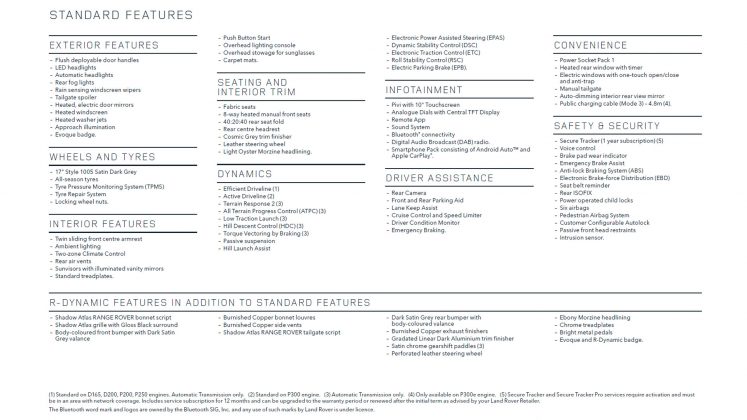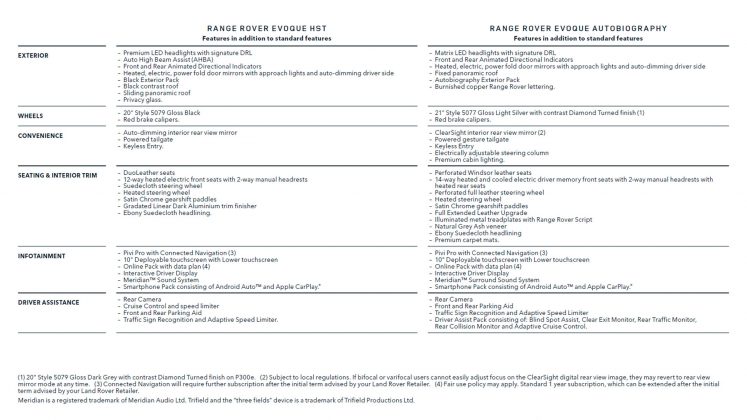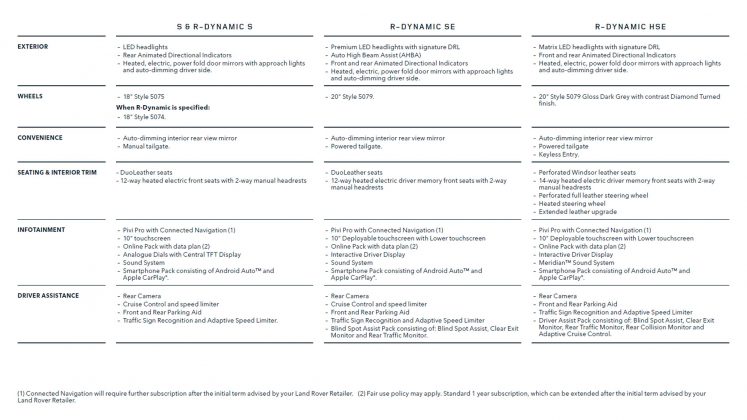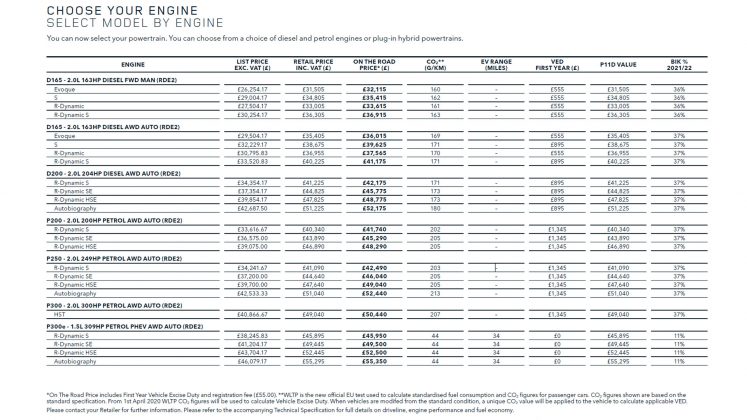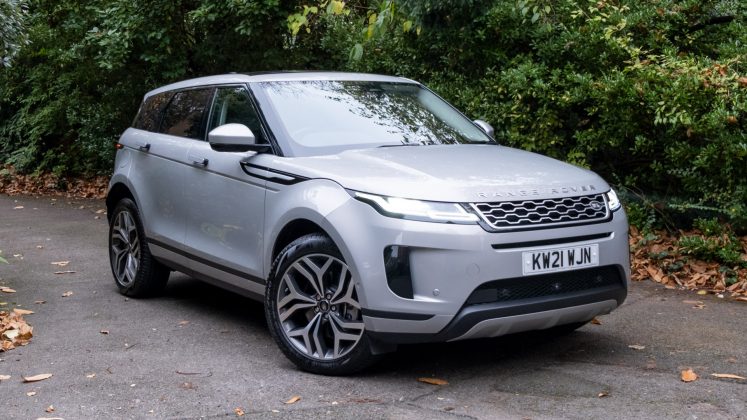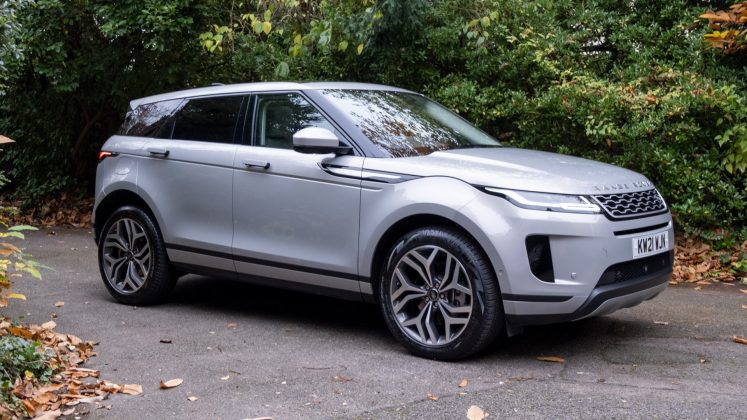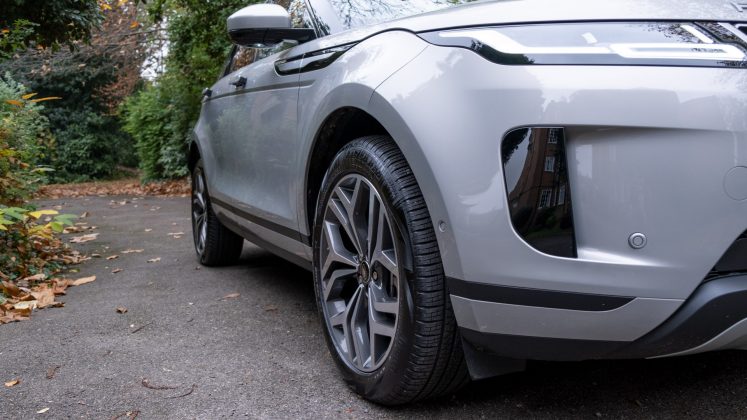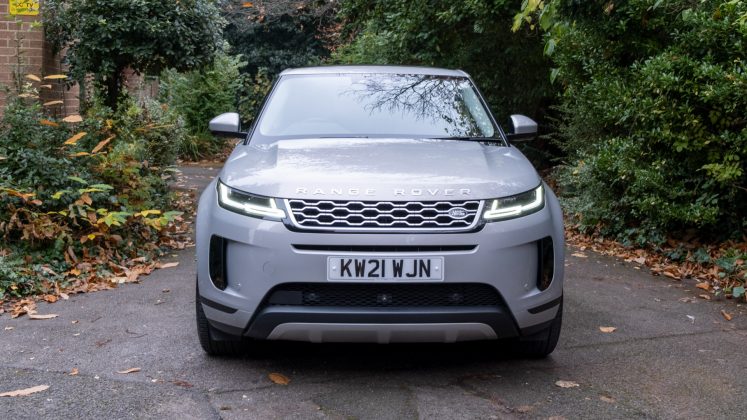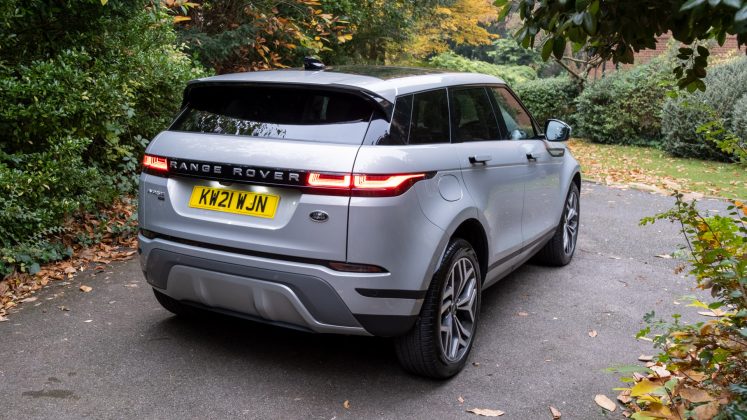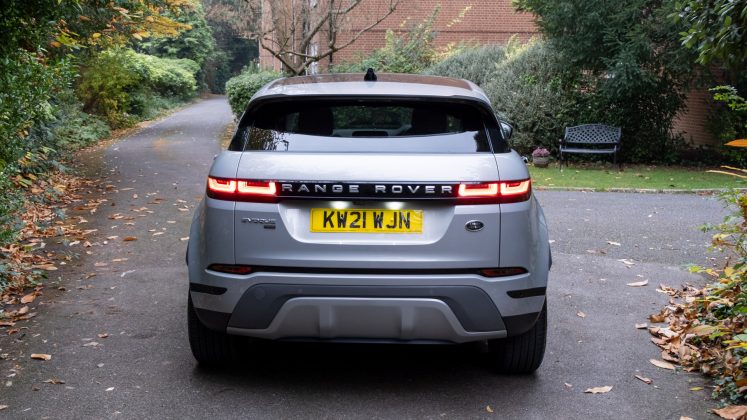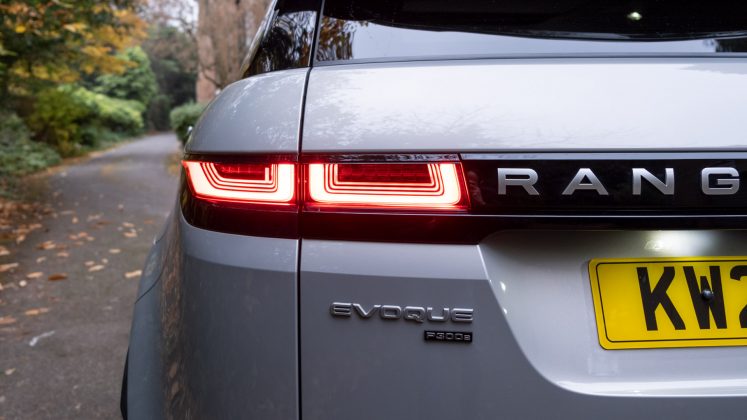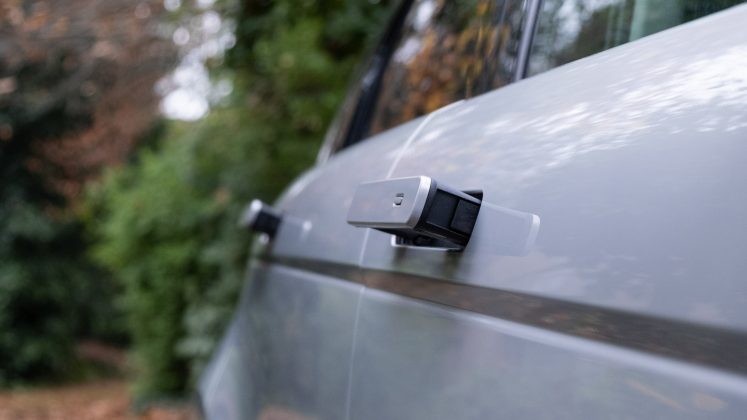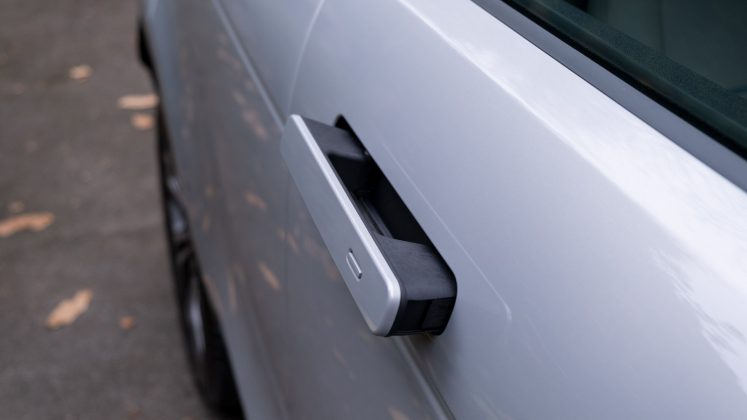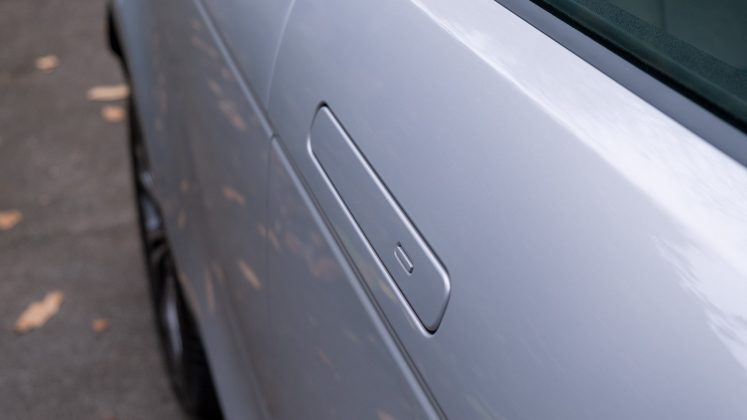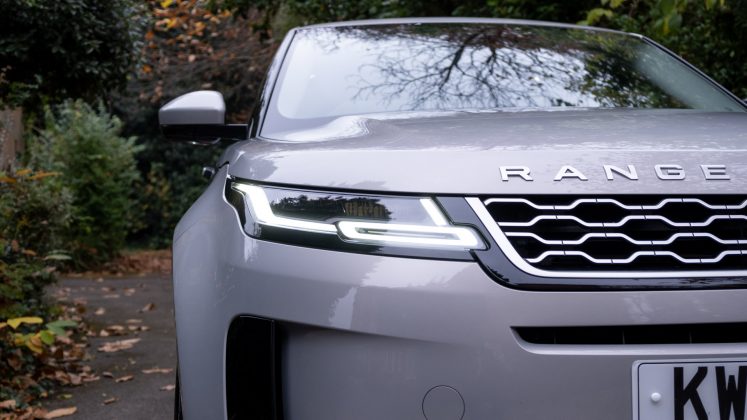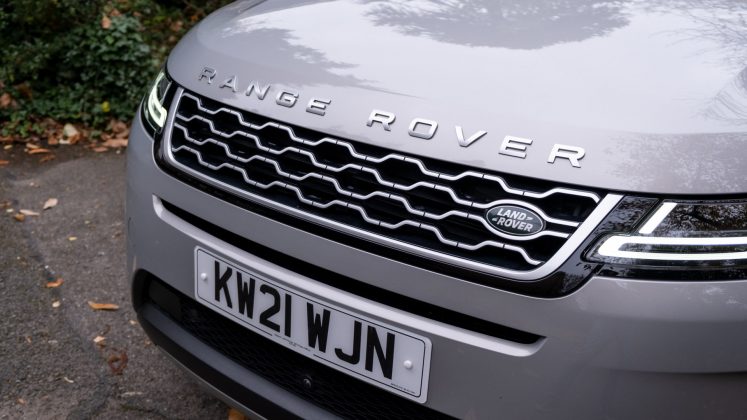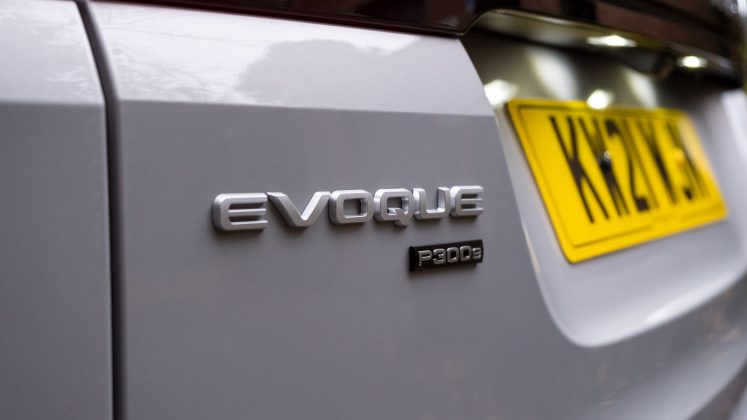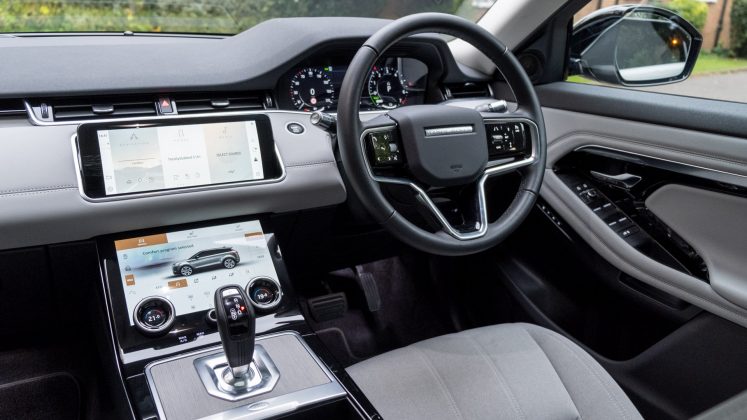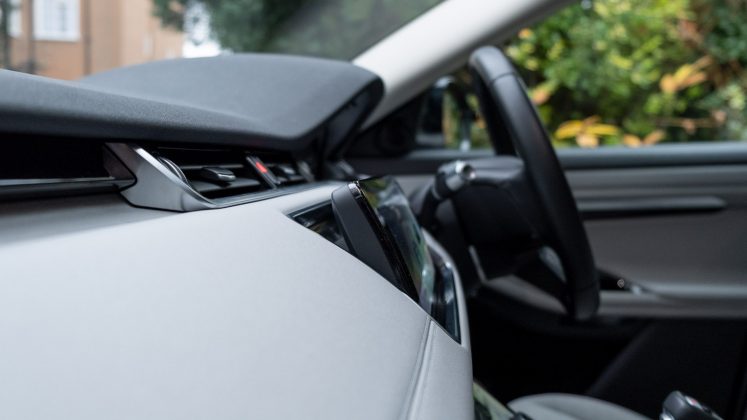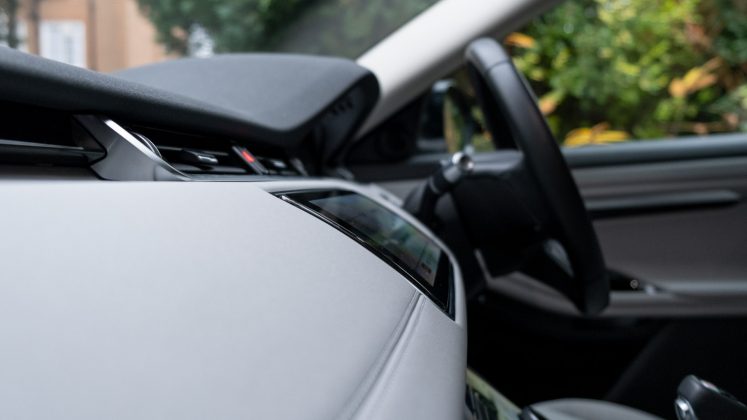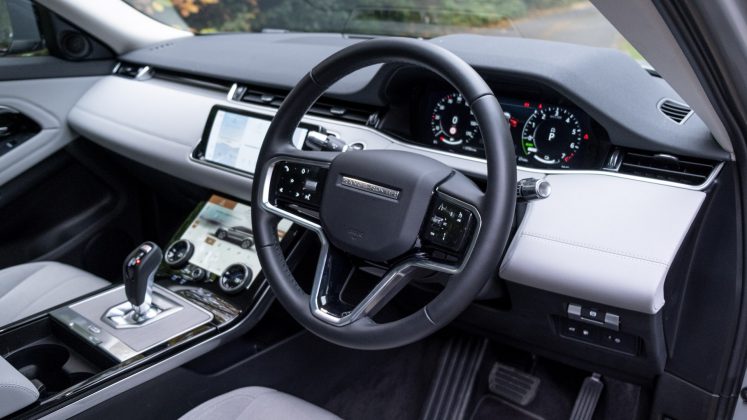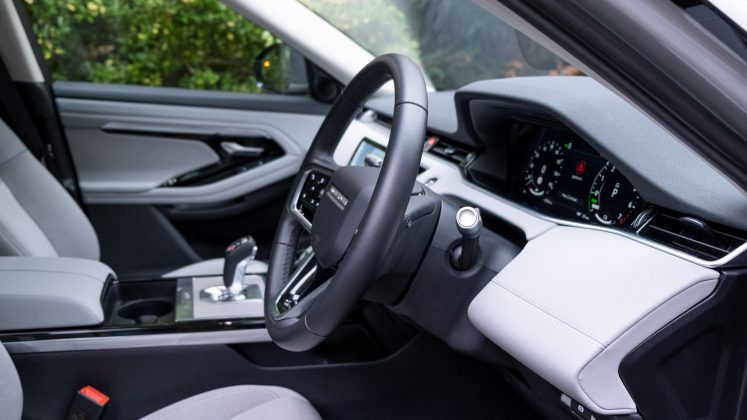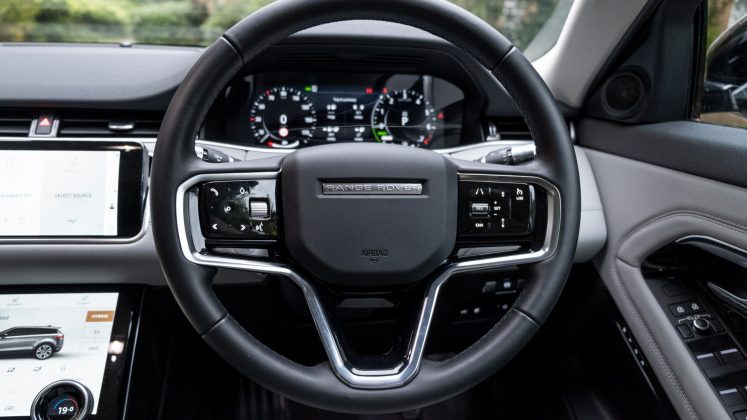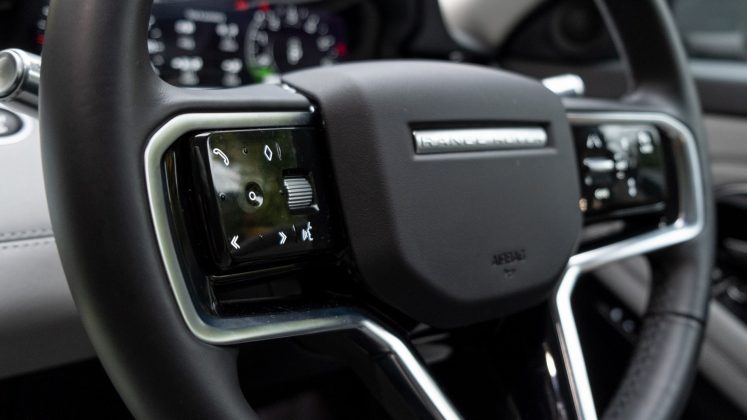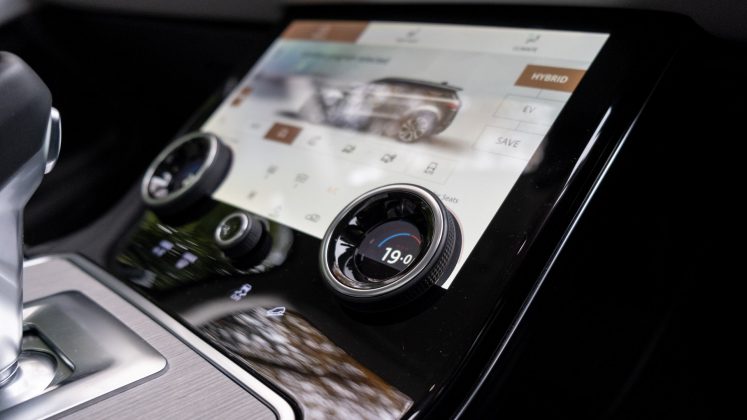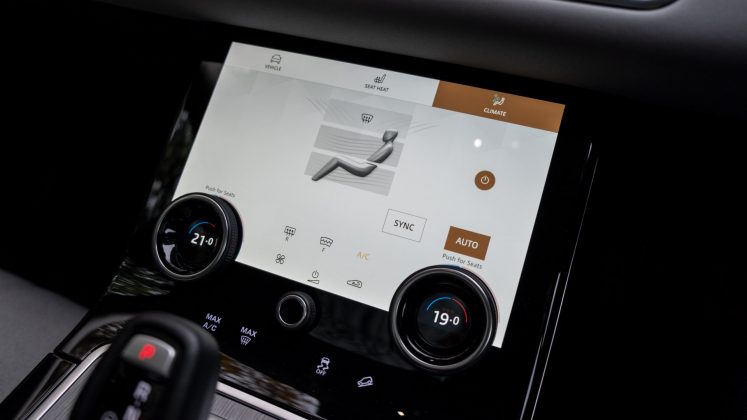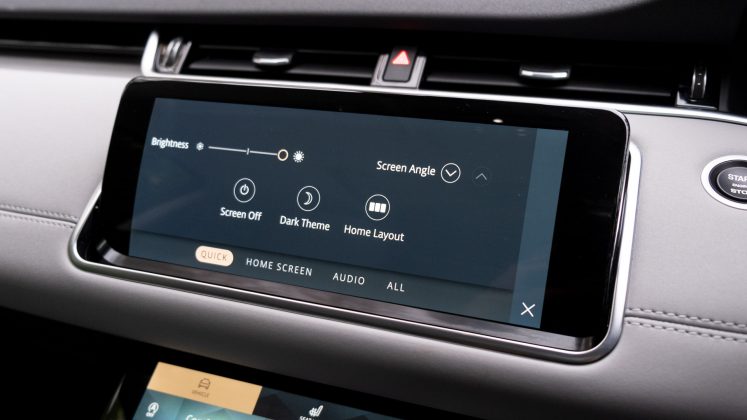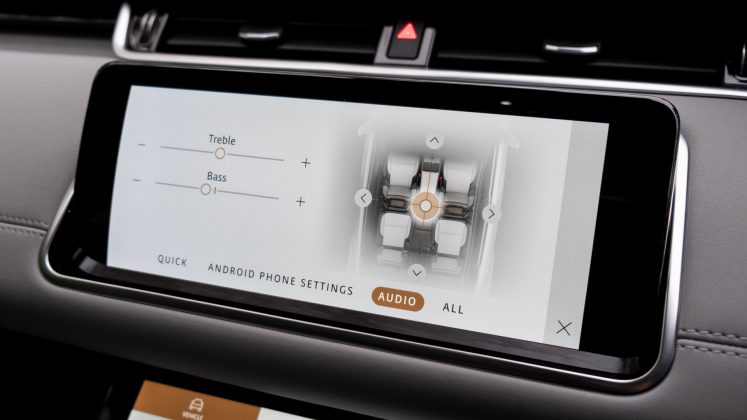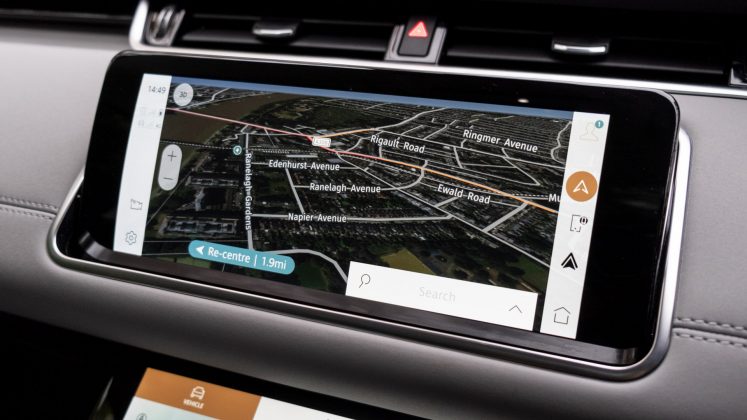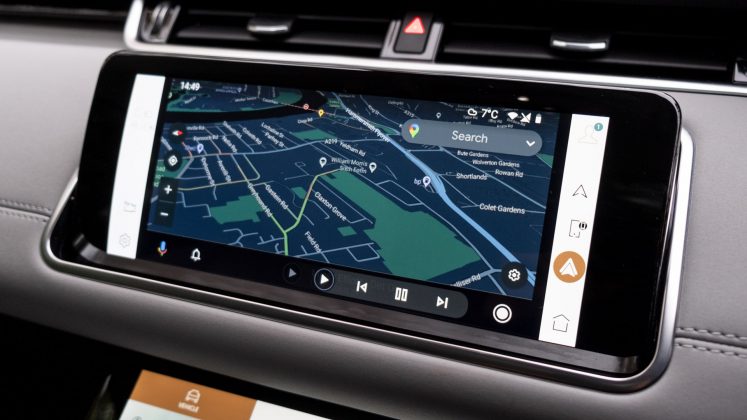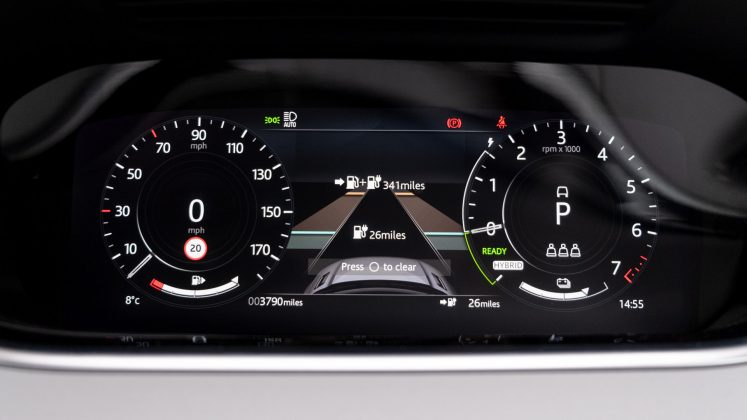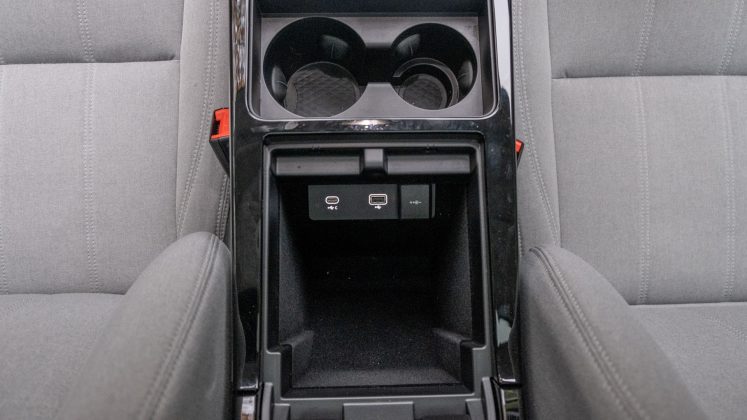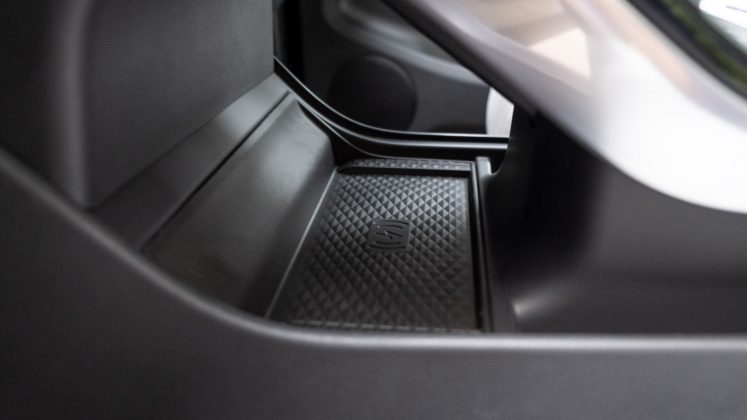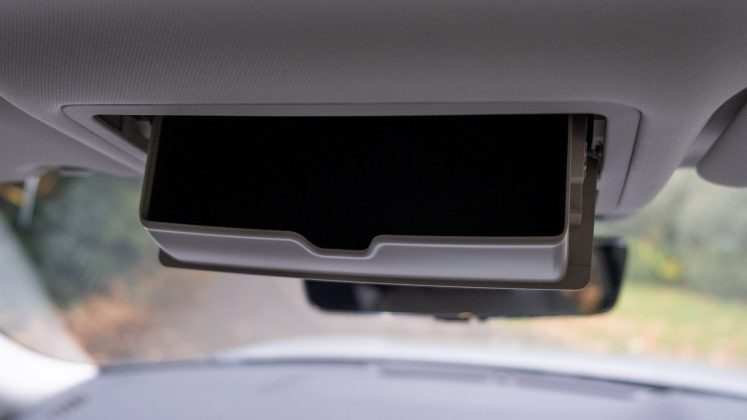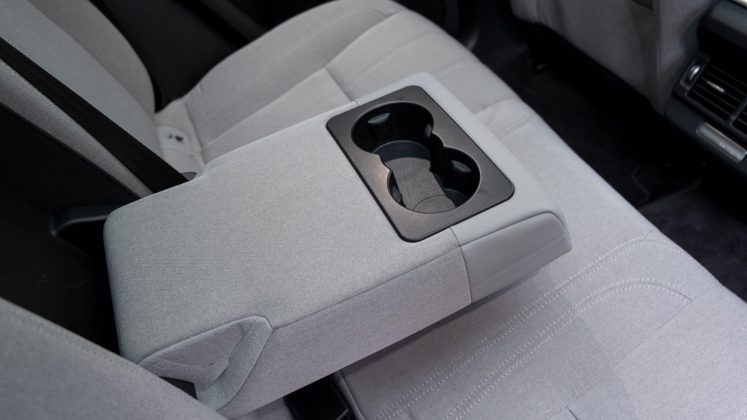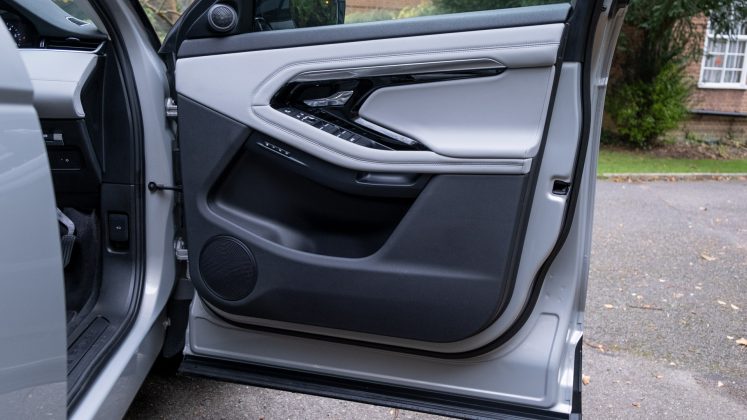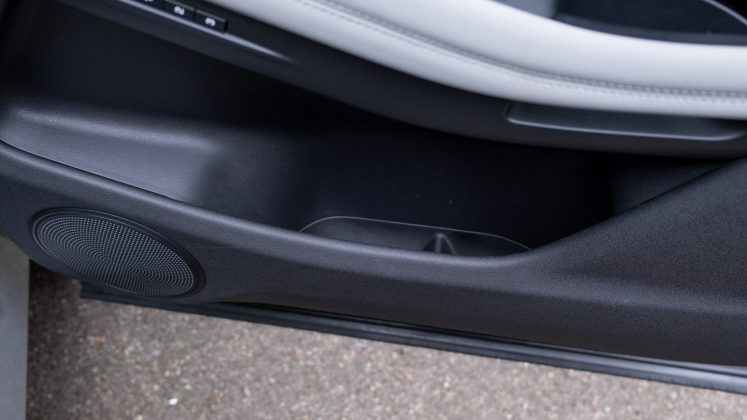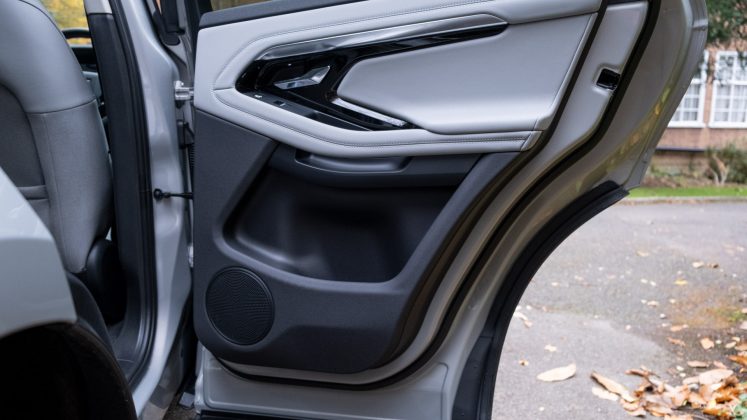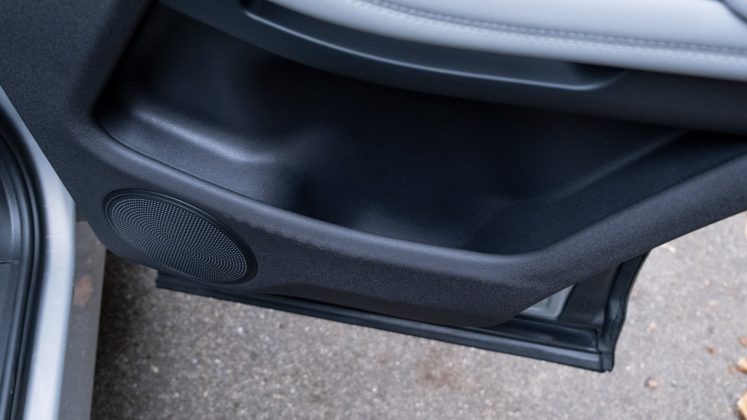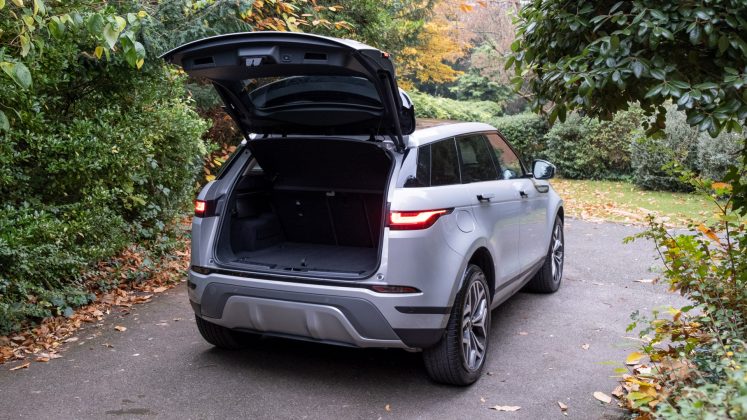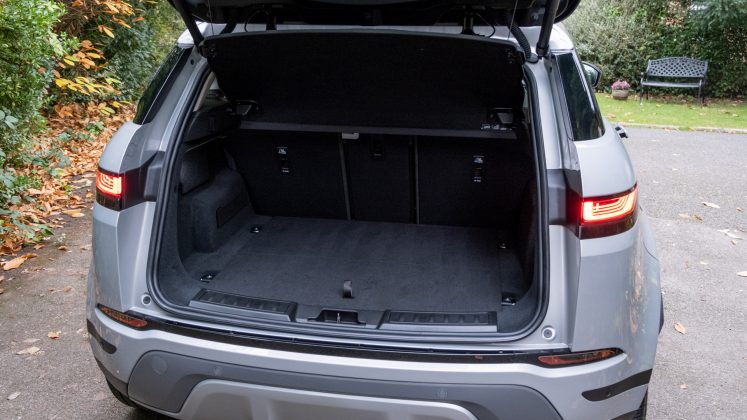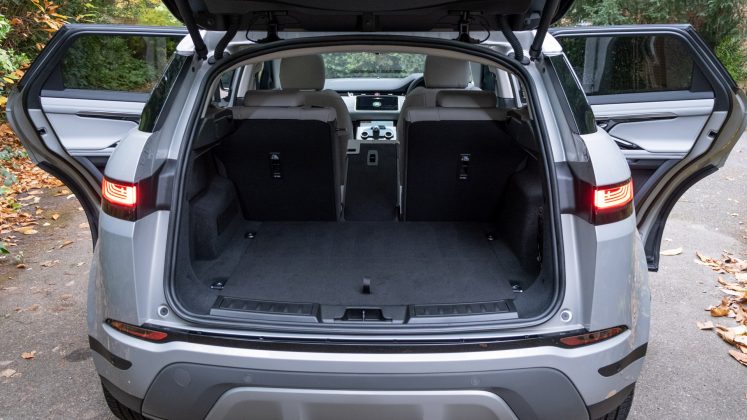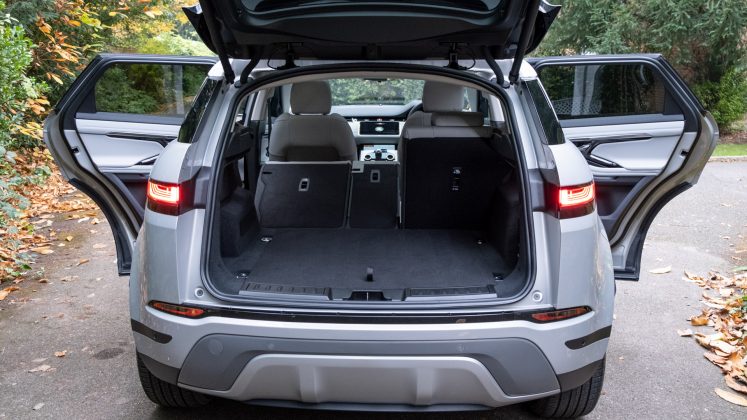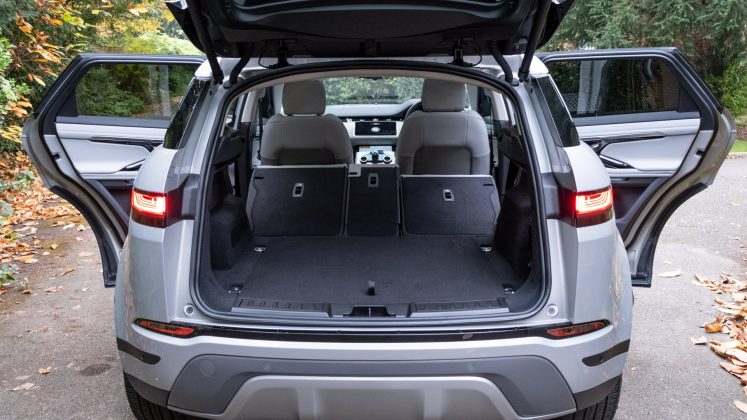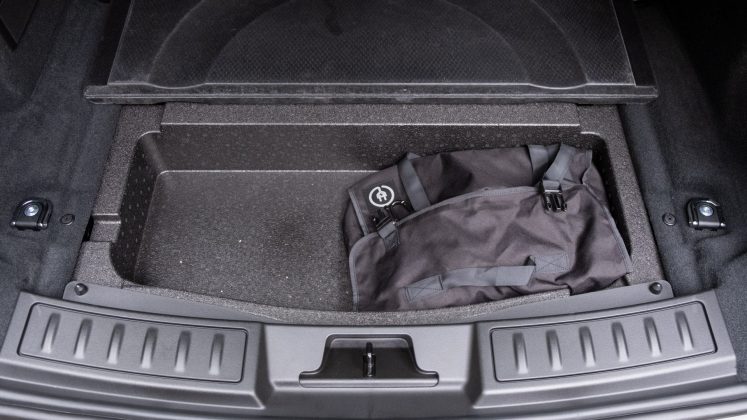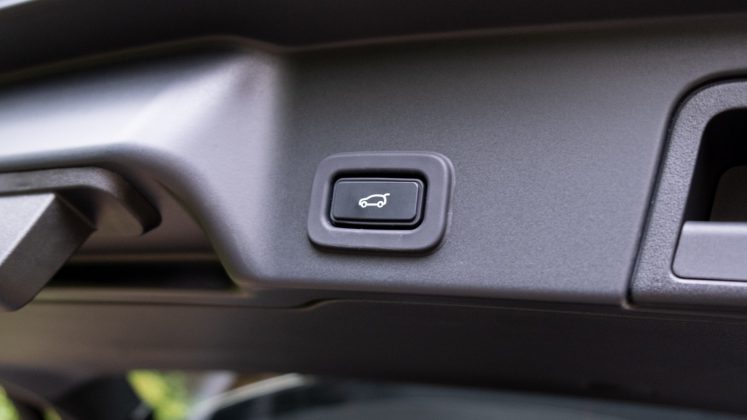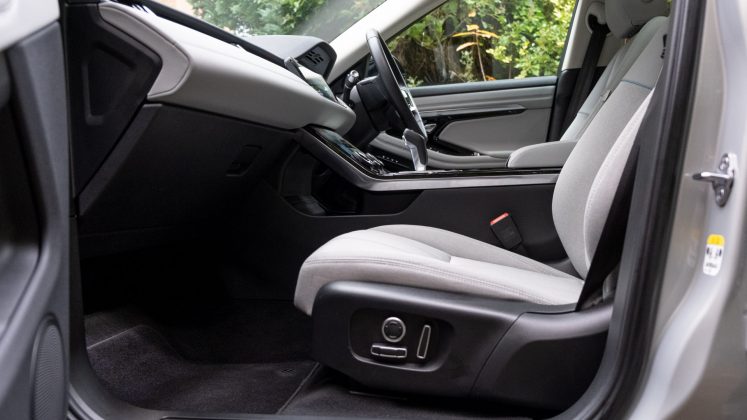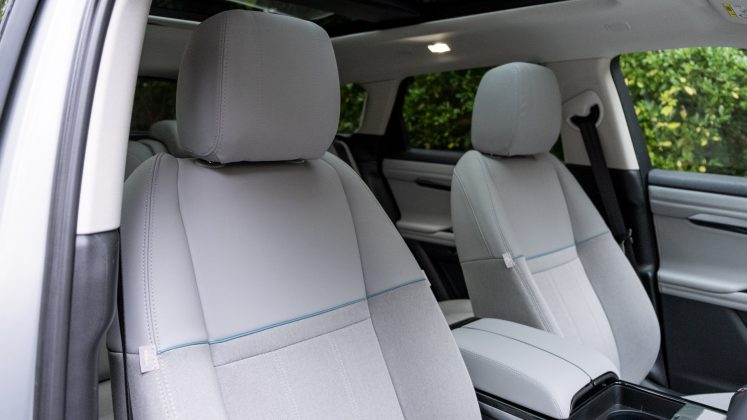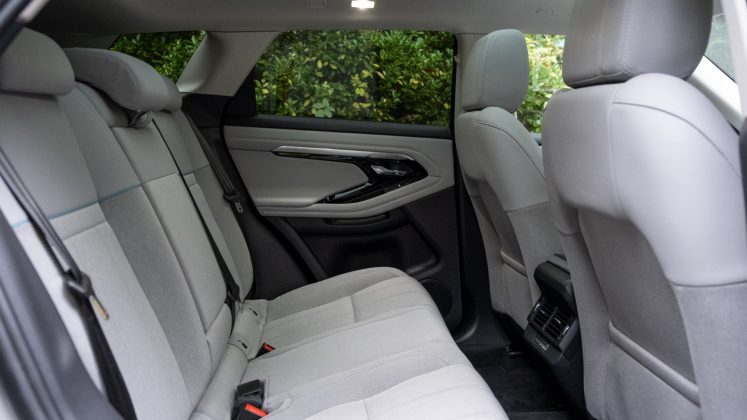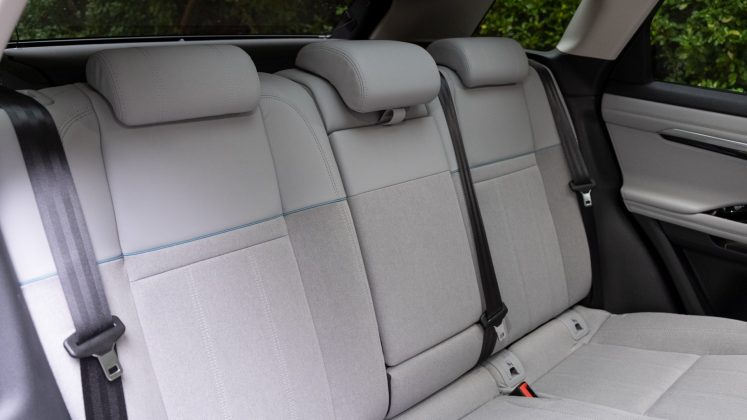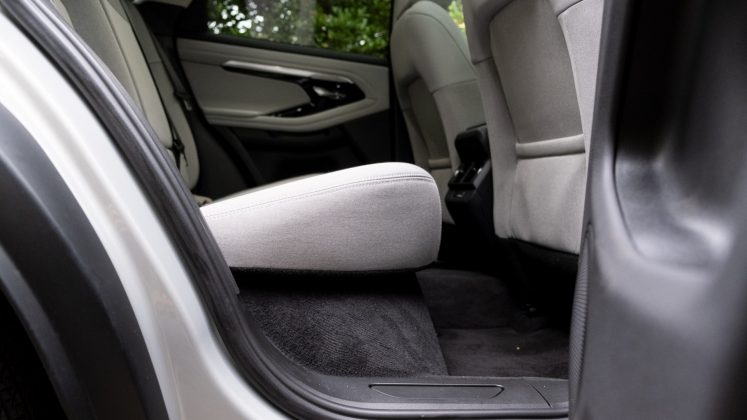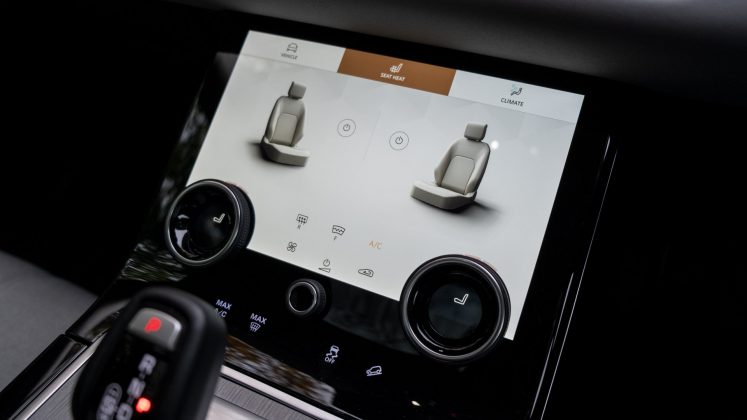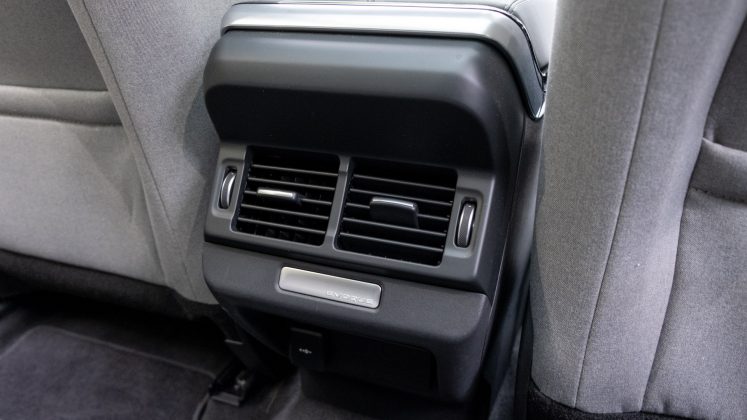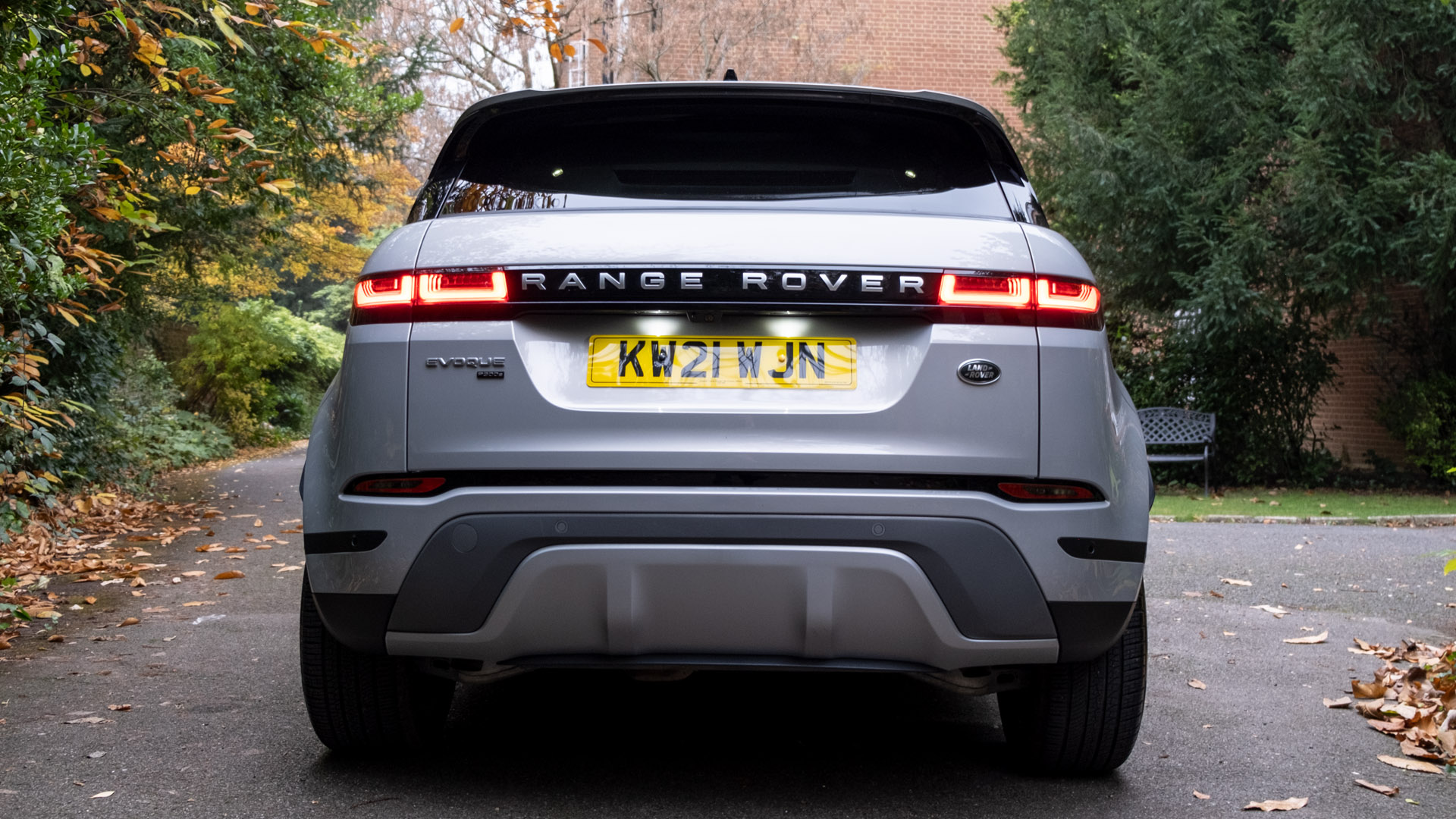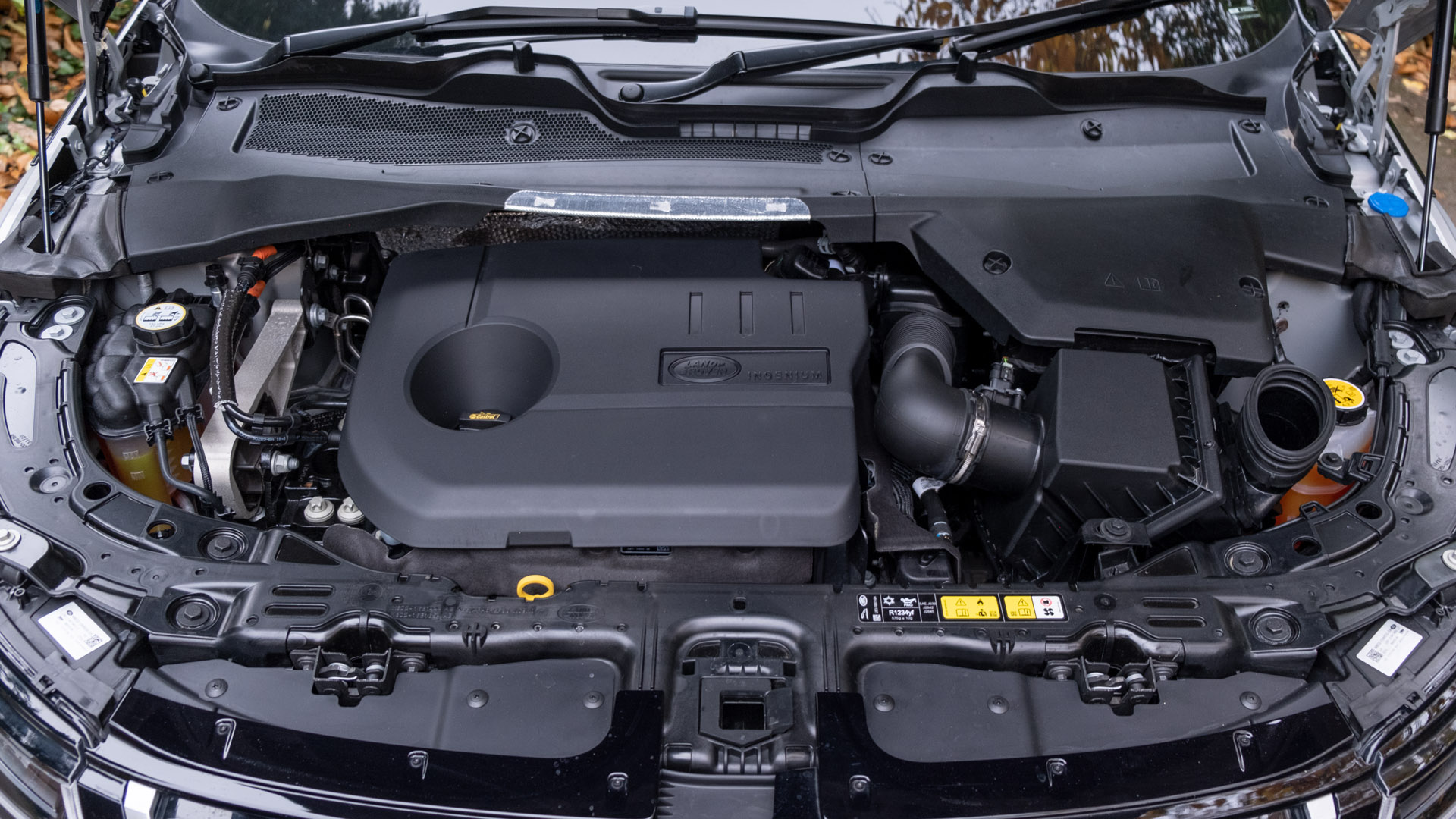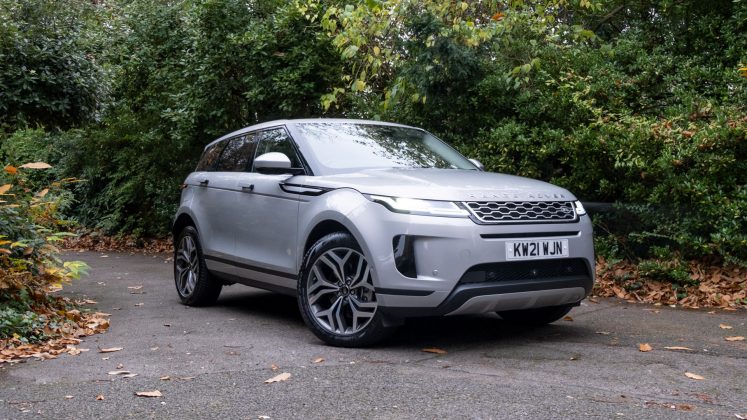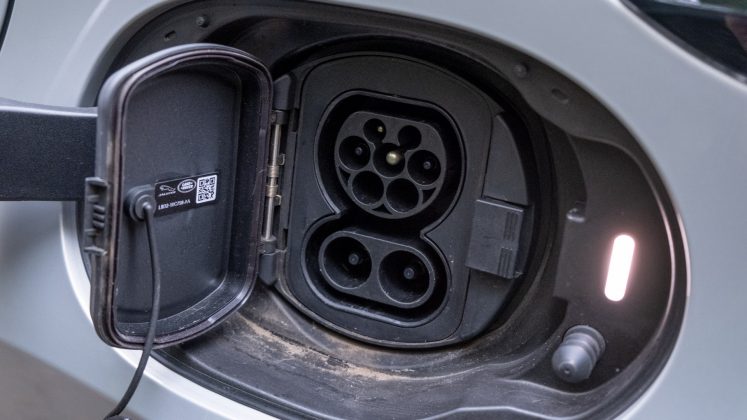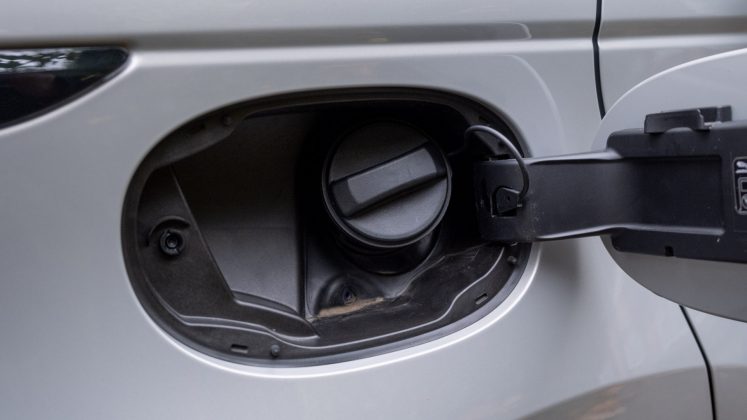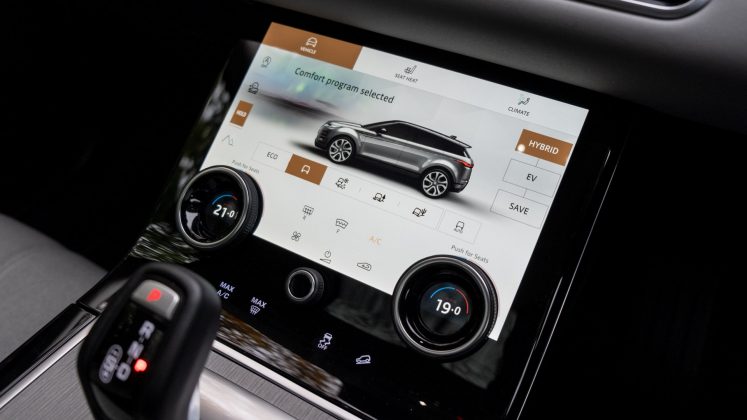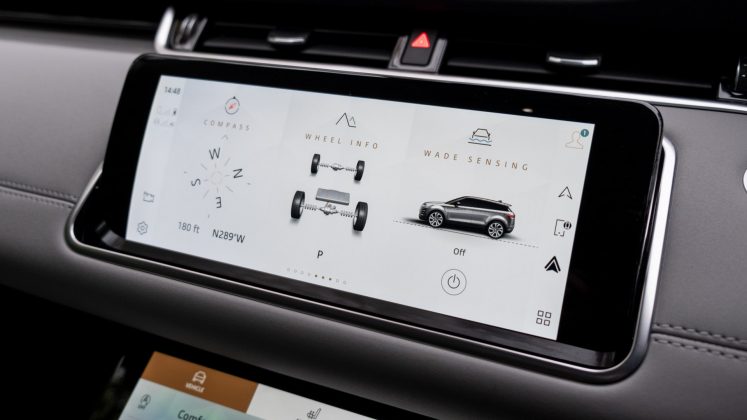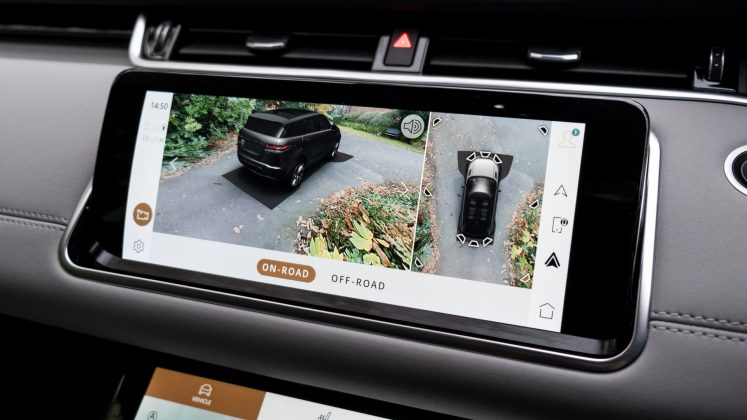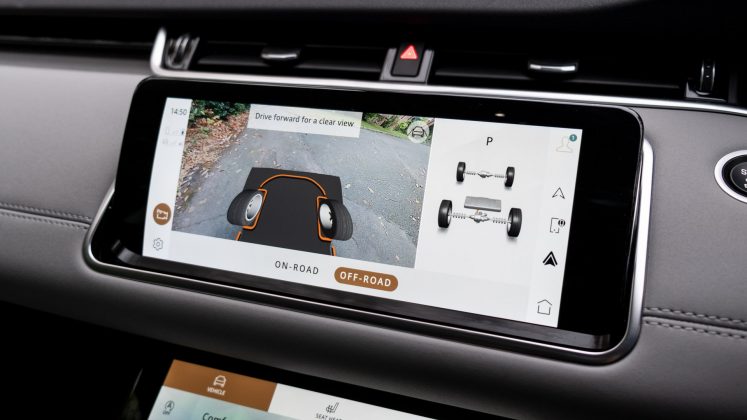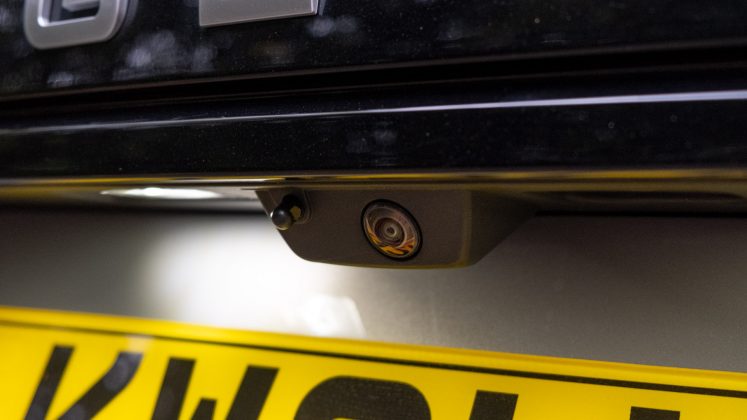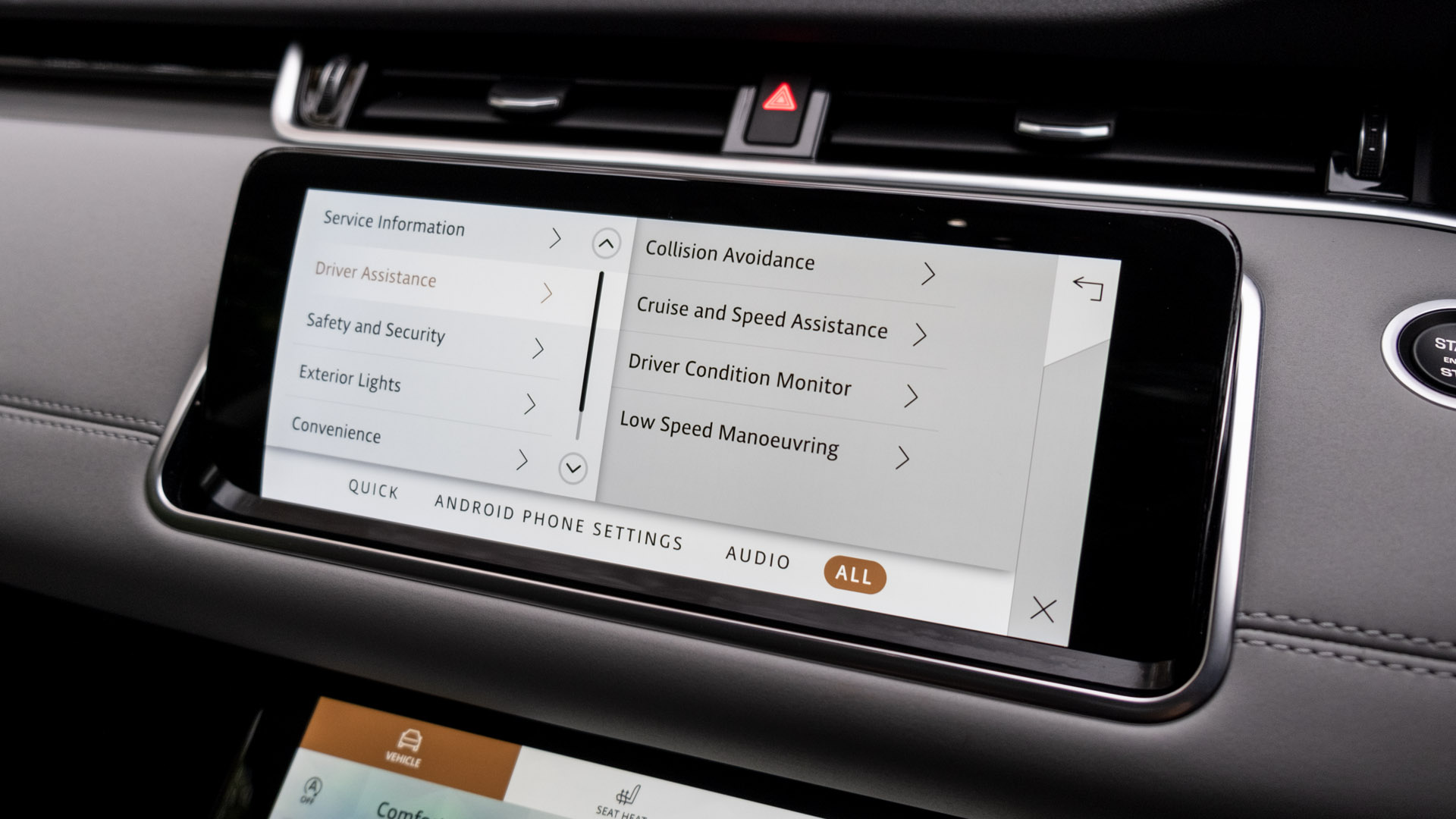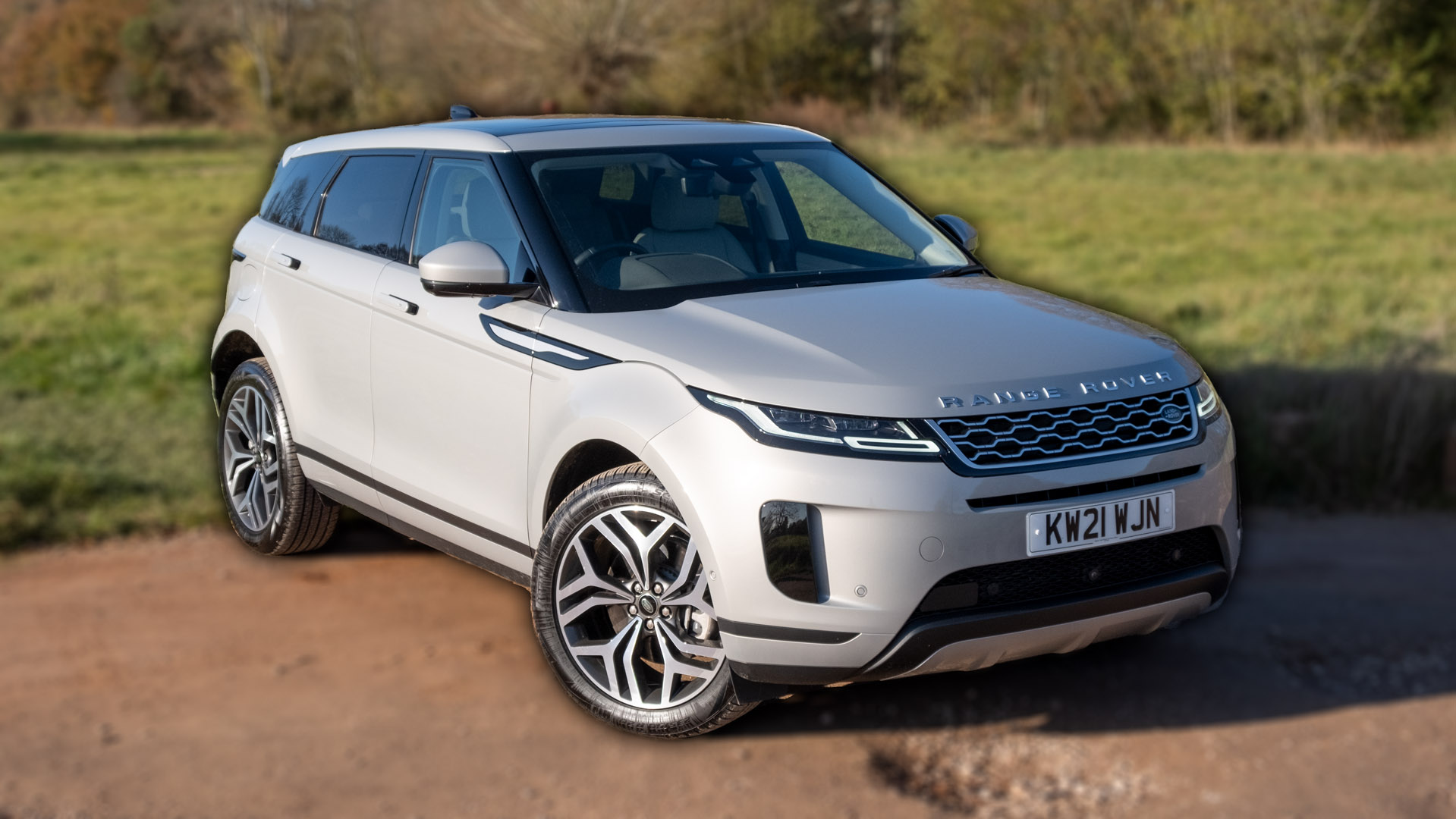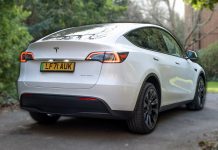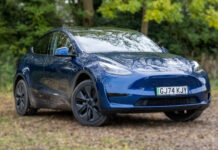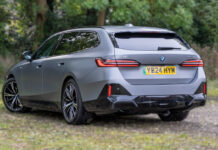In late 2018, Land Rover revealed the second-generation Evoque. For the first time, the compact SUV was made available as a mild-hybrid (MHEV) and plug-in hybrid electric vehicle (PHEV). These models represented a new era of electrification for the automaker, especially the latter model that houses a 15 kWh battery pack.
Combined with its electric motor, the P300e plug-in hybrid, is the most powerful Evoque in the manufacturer’s line-up. It also has a lowered Benefit-in-Kind (BIK) tax rate of 11% and thanks to its battery, the automaker claims it can run up to 34 miles on pure electric power. In turn, this helps reduce its tailpipe emissions from over 160g/km down to 44g/km.
If you’d prefer to watch a review of the Range Rover Evoque, head on over to our YouTube channel.
Range Rover Evoque price & competition
It will undoubtedly grasp your attention, however, the PHEV model is also the most expensive in the Evoque line. The P300e R-Dynamic S starts from £45,950, with prices going up to £55,350 for the top-spec Autobiography. Considering the lower-powered Evoque D165 starts from £32,115 it’s quite a substantial price difference; of course, it’s not a fair comparison given the P300e outputs 309hp as opposed to the 163hp of its pure diesel sibling.
Find the best Range Rover Evoque deals
A breakdown of what you get as standard can be found, below. Note, the PHEV model is currently available in the higher-spec R-Dynamic S, SE, HSE and Autobiography trims (click to expand):
When it comes to competition in the PHEV space, there’s the Jeep Renegade 4xe (£32,600), Cupra Formentor e-Hybrid (£36,170), Audi Q3 TFSIe (£38,335), Volvo XC40 Recharge (£39,130), BMW X2 xDrive 25e (£39,390) and Mercedes GLA 250 e (£39,995) to name just a few.
Within the realms of fully electric premium SUVs there’s the Skoda Enyaq iV 80 from £39,365 (331 miles WLTP), the Mercedes EQA 250 from £44,495 (263 miles WLTP); the Audi Q4 40 e-tron at £44,990 (316 miles WLTP); the Volvo XC40 Recharge Twin at £49,950 (259 miles WLTP); the BMW iX3 from £59,730 (285 miles WLTP); the larger Audi e-tron at £62,025 (227-271 miles WLTP); the Jaguar I-Pace at £65,245 (292 miles WLTP); the Mercedes EQC at £65,720 (255 miles WLTP); and the Tesla Model X at £102,980 (348 miles WLTP).
Read next: BMW 330e M Sport Touring first drive: The ultimate hybrid estate?
Range Rover Evoque exterior review
Given the Range Rover’s price tag one might expect a premium exterior design, and indeed Land Rover has hit the mark with the Evoque’s styling. At the front, the vehicle has a cute bubble-shaped design but yet incites class with its headlights and smooth lines that stretch across the frontal design.
Its rear profile should also be praised. Here, the automaker has incorporated a functional rear bumper that bolsters its off-roading capabilities, while the taillights and spoiler invoke both a futuristic and sporty appearance. It’s quite the looker from the side too; body-coloured wheel arches and sideskirts cement the vehicle’s premium design, while its 18″ or pictured 20″ diamond-turned alloys add a sporty flair.
Read next: Our favourite power banks for long journeys
Another area of interest is its door handles; they’re cleverly concealed within the door frames while the car is rolling or indeed locked, but when unlocked they prop open from the vehicle’s body. This small, yet appreciated touch also adds to the overall exterior aesthetics.
As for colour options, it comes as standard in the solid ‘Fuji White’ finish. Should you want any of the metallic finishes, such as ‘Santorini Black’, ‘Eiger Grey’, ‘Portofino Blue’, ‘Ostuni Pearl White’, ‘Lantau Bronze’, ‘Firenze Red’, ‘Nolita Grey’ or the pictured ‘Seoul Pearl Silver’ it’ll come in at a £705 premium. You can also opt for the two premium metallic finishes, ‘Carpathian Grey’ and ‘Silicon Silver’ for £970.
Read next: Kia e-Niro review: The best all-electric SUV?
Range Rover Evoque interior review
Its exterior design, in our opinion, is very stylish but so is the Evoque’s interior. From the layout of the cabin to its look, namely in the R-Dynamic SE that we have on review, which features two touchscreen displays and a fully digitalized 12.3″ instrument cluster. In the entry-level R-Dynamic S, however, it’s not as lavish whereby there’s a singular 10″ touchscreen display and a part-digital, part-analogue instrument cluster that we find brings down the overall aesthetics within the cabin. No matter which trim level you go for, it should be noted that there’s a bit of creeky plastic around the centre console unit.
Moving onto the steering wheel, it’s great to see that the automaker has spent some time refining its layout. On the left, there are media controls including a physical volume wheel, where these double up as instrument cluster controls, too; pressing on the centre button dynamically changes the backlight and provides arrows to navigate your settings. On the right-hand side, there are cruise control buttons and an easy means of enabling lane-keep assist – pressing on the dedicated button illuminates it in green.
Past the steering wheel, there’s also the option to add a Head-Up Display (HUD) for £700; this bolsters safety and provides a means of checking the vehicle’s speed without having to glance down at the speedometer.
Read next: BMW X2 xDrive25e review: A sporty hybrid crossover
Focusing on the use of technology, it’s great to see that the Evoque supports both Android Auto and Apple CarPlay in both a wired and wireless format through its infotainment system. The display itself is responsive, easy to navigate, and in the R-Dynamic SE, can be vertically tilted to a certain degree; dark and white modes also help to see the display in low-light or bright ambient light conditions, respectively.
As for the secondary display on the R-Dynamic SE, it provides shortcuts to certain vehicle settings and access to the vehicle’s climate controls. While this screen is visually appealing, it’s not as intuitive for adjusting certain climate settings – take for example the fan speed, you need to tap on a capacitive button, then rotate the physical dial on the left-hand side; a non-issue if you’re at a standstill but rather dangerous if you’re wanting to change the fan speed while you’re driving. On the plus side, the two physical knobs on the display allow you to independently adjust the temperature and by clicking on the dial one can tinker with the seat heater, too.
Elsewhere, there are six speakers located within the cabin; the overall audio quality is somewhat lacklustre, and we were left disappointed. If you’d like to hear how the stock system performs, watch our dedicated review of it on YouTube.
Range Rover Evoque storage review
When it comes to storage within the cabin, the Evoque has plenty of pockets of space. At the front, there’s a rather large area under the centre console for a smartphone; should you opt for a £300 option, you’ll find a wireless phone charger in this vicinity too.
By the centre console, there are two cupholders and a compartment within the centre armrest that’s large enough for a small-sized purse, makeup bag or wallet. A 12V socket, USB Type-A and Type-C ports are also located within this compartment, whereby allowing you to connect up to the infotainment system or charge a device. Another 12V socket can be found towards the rear of the centre console, too. Above the centre console, there’s a handy place to store your sunglasses – a nice little touch by the automaker.
As for the door bins, they’re large enough at the front of the cabin for a 500ml bottle and some small valuables but at the rear storage capacity is a little more limited. Two cupholders can be found within the rear armrest, too.
Read next: The best dash cams to mount inside your vehicle
Should you want to take more goods, there’s the boot. Here, Land Rover offers 591 litres of cargo capacity and with the seats folded flat, extends up to 1,383 litres. By comparison, the Cupra Formentor e-Hybrid has 345/1,475 litres, the BMW X2 xDrive 25e offers 410/1,290 litres, while the Land Rover Discovery Sport P300e has a humongous 1,179/1,794 litres instead. Granted the Evoque’s boot isn’t as big as some of its competitors, but we find the total capacity will suffice for most consumers.
To solidify our point, there’s a seizable underfloor compartment where one can store both home and public charging cables. The seats are similarly well-designed as they have a 40:20:40 split design and can be fully folded flat, making it convenient to take elongated goods. Our only complaint, however, is that a powered tailgate doesn’t come as standard in the R-Dynamic S trim, but is present in the more expensive R-Dynamic SE trim that’s on review.
Read next: Cupra Formentor e-Hybrid review: Better than BMW X2?
Range Rover Evoque comfort review
Now while there’s a sufficient amount of space within the cabin to store your valuables, legroom and headroom for 6-foot 2-inches (188cm) individuals is a little limited, especially at the rear of the cabin. At the front, it similarly feels a little restricted, however, thanks to the inclusion of 12-way heated electric seats, one can get a bit more comfort.
As for the seats themselves, the four main seats are plush and provide good lower back support, while the rear middle seat is unsurprisingly stiff. In terms of cabin noise, the Evoque also provide good passive noise isolation, although, does suffer from a bit of tyre noise creeping in at higher speeds – a detailed breakdown of the Evoque’s cabin noise can be found on our dedicated audio review.
On the whole, the comfort within the cabin is good, but there are plenty of additional comfort options that don’t come fitted as standard – and one might expect them all to be included given the initial asking price of £45,950.
Find the best Range Rover Evoque deals
Take, for example, rear climate controls they come in at £205; heated steering wheel costs £190; a sliding panoramic sunroof costs £1,600, or £1,150 if you don’t mind a fixed design; the rear privacy glass costs £450; the cabin purifier is £335; and keyless entry comes in at a whopping £420. Of course, there are also many other options that Land Rover offers, all of which drive up the price of this already-expensive vehicle.
Read next: Citroen C5 Aircross Hybrid review: A comfy and roomy PHEV
Range Rover Evoque performance review
This brings us onto the subject of driving comfort. Here, the Evoque has slightly stiffened suspension, which means speed bumps and potholes can be felt when pottering around town, namely when compared to the Land Rover Discovery Sport or vehicles that come fitted with an active air suspension system.
There’s also a slight degree of body roll when cornering at speed, whereby you won’t get the same level of confidence on windy country roads as the BMW or Volvo equivalent. Similarly, the steering wheel lacks that sense of connection with the front axle, meaning you don’t get a real driver’s feel. Meanwhile Range Rover’s SUV, at least in our opinion, isn’t supposed to invoke a sporty flair; it’s a stylish vehicle that many will use to drive around town and occasionally go to the countryside.
Still, the P300e is the most powerful Evoque within Range Rover’s fleet. Indeed, its front-mounted 1.5-litre three-cylinder engine outputs 197 hp of power, and when combined with the rear-mounted 80 kW (109 hp) electric motor they produce up to 230 kW (309 hp) and 540 Nm of torque; we achieved 0-60mph in 6.85 seconds. Granted that’s not as impressive as its all-electric rivals nor sportier SUVs on the market, but we suspect it’ll suffice for most consumers. As for top speed, it’ll get up to 132mph, while in pure electric mode one can attain a speed of 84mph.
Moving onto its transmission, the Evoque houses an eight-speed automatic gearbox. It’s buttery smooth and can be tinkered by shifting to Sport mode via the gear selector. One can also praise the automaker’s seamless transition between the electric and petrol powertrains; you can’t feel the shift and can only hear the three-cylinder engine trickling away towards the front of the vehicle.
Read next: The best dash cams to mount inside your vehicle
This leads us to the 15 kWh battery pack, which is claimed to provide 34 miles of all-electric range. In our mixed driving tests, however, we netted around 25 miles – an average performance for a plug-in hybrid but certainly no match for an all-electric SUV. The issue we have, however, stems from its 57-litre fuel tank; when the battery is exhausted, fuel efficiency plummets. Here, we netted only 40 MPG, where we suspect one can attain a much better figure in the pure petrol or diesel alternative. Comparatively, the Cupra Formentor e-Hybrid achieved 64 MPG, the Citroen C5 Aircross Hybrid 58 MPG, the BMW X2 xDrive 25e netted around 39 MPG, while the Jeep Renegade 4xe attained a measly 36 MPG.
Thankfully, Land Rover has included rapid charging via a CCS port, which accepts up to 32 kW of input. This allows you to connect up to a 50 kW DC charger, and attain 0-80% in just 30 minutes. Plugged into a 7 kW charger, this figure goes up to 90 minutes instead. As for a 3-pin wall socket, it’ll take 6hrs 40mins.
To round off the vehicle’s performance we should also reference its off-roading capabilities. True to the brand’s ethos, the Evoque can be taken on tougher trails. The vehicle can automatically detect the terrain or can be manually set in the right mode by selecting the appropriate setting through the infotainment system. You have a wading depth of 530mm, a ride height of 212mm, a kerb-to-kerb turning circle of 11.6m (11.9m if measured wall-to-wall), supports a roof load of 75kg, and has a towing capacity of 750kg for an unbraked trailer, while 1,600kg can be towed if it’s braked.
The only thing to be mindful of is if you’re in all-electric mode, you’ll be limited to a rear-wheel drive (RWD) system only. Should you want the all-wheel drive (AWD) system to be in operation you’ll have to engage the petrol engine – it automatically kicks into life when you select one of the off-road modes.
Read next: Volvo XC40 Recharge Twin review: A powerful luxury electric SUV
Range Rover Evoque safety review
On the subject of going off-road, the Evoque has excellent visibility around the front and sides, however, the rear is quite limited. Thankfully, Land Rover includes a rearview camera, and front and rear parking sensors as standard. You can bolster the experience by choosing the £585 3D Surround Camera option, which provides a better view of your front tyres – useful when traversing rocky terrain or when parking.
Speaking of which, the £515 ClearSight interior rearview mirror is ingenious for checking your surroundings, be it at snail-pace or while driving. It integrates the vehicle’s rearview camera feed onto the rearview mirror; this can easily be toggled by flicking a switch on the mirror.
As for the Evoque’s crash rating, it received 5/5 stars from Euro NCAP; scoring particularly well in the Adult and Child Occupancy tests – 94% and 87%, respectively. It also did relatively well in the Safety Assist tests, scoring a respectable 73%. Here, the R-Dynamic S has Lane Keep Assist, Cruise Control and Adaptive Speed Limiter, Driver Condition Monitor, and an Emergency Braking system. Should you want Blind Spot Assist, Clear Exit Monitor and Rear Traffic Monitor, you’ll need to opt for the R-Dynamic SE or above.
In our tests, we found Lane Keep Assist rather primitive, where it would only intervene in certain conditions, while Adaptive Cruise Control, which features as an option within the £1,150 Driver Assist Pack didn’t work well; it failed to actively recognise the vehicle in front and thus struggled to keep a consistently safe distance from the leading vehicle.
Read next: Skoda Enyaq iV review: The Volkswagen ID.4 alternative
TotallyEV’s verdict on the Range Rover Evoque P300e
On the whole, the Range Rover Evoque P300e is a stylish and compact SUV. However, given its £45,950 asking price, fuel efficiency, electric range and performance it’s hard to recommend over rival PHEVs.
Find the best Range Rover Evoque deals
To name just a few plug-in hybrids, there’s the Cupra Formentor e-Hybrid (£36,170), Audi Q3 TFSIe (£38,335), Volvo XC40 Recharge (£39,130), and the BMW X2 xDrive 25e (£39,390). Similarly, there are numerous all-electric SUVs you might want to consider if you want to greatly reduce your tailpipe emissions or BIK rate; examples include the Skoda Enyaq iV 80 (£39,365), Audi Q4 40 e-tron (£44,990), and the Volvo XC40 Recharge Twin (£49,950).
Ultimately, we’d recommend one of the aforementioned vehicles instead, but we’d love to hear if and why you’d pick the Range Rover Evoque P300e over one of its rivals. Let us know in the comments section below or via social media; we’re on: YouTube, Instagram, Facebook, Twitter and LinkedIn.

